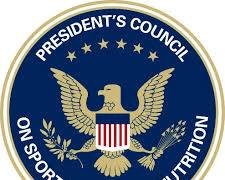Each year, President's Day reminds us of the leaders who have shaped our nation. But did you know that throughout history, some presidents have also made major contributions to promoting physical fitness for Americans? Here's a look at the highs, lows, and potential for improvement when it comes to presidential support for a fit and healthy nation.
The Early Champions
Theodore Roosevelt: A strenuous advocate for the outdoors and robust living, Roosevelt saw physical weakness as a national problem. He famously challenged Marine officers to 50-mile hikes and promoted sports and athleticism.
Muir and Roosevelt posed at Glacier Point in Yosemite. Creative Commons
John F. Kennedy: Inspired by studies showing American children lagging behind their European counterparts in fitness, JFK made physical education a priority. His article "The Soft American" in Sports Illustrated sounded a national alarm bell about declining fitness levels.
The Kennedys were famed for their touch football games, which brought a spirit of youthful fitness to the nation’s highest office. (Paul Schutzer/Time-Life Pictures/Getty Images)
The Establishment of the President's Council
In 1956, Dwight D. Eisenhower created the President's Council on Youth Fitness, the precursor to today's President's Council on Sports, Fitness & Nutrition (PCSFN). Since then, the Council has served as a key federal advisory committee to promote physical activity.


High Points of Presidential Fitness Initiatives
Physical Fitness Awards: Programs like the Presidential Youth Fitness Program encourage fitness testing and recognition for youth. These programs can play a key role in establishing lifelong fitness habits.
National Youth Sports Strategy: Launched in 2015, this initiative seeks to increase participation in youth sports for kids from all backgrounds, recognizing the potential benefits of regular physical activity.
Focus on Nutrition: Recent presidents, like Barack Obama, have broadened the focus to include healthy eating along with physical activity, a vital step in addressing issues like obesity and chronic disease.
President Obama checks out a boy's harvest as he joins First Lady Michelle Obama, students from "Let's Move!" programs and others participating in the fall harvest in the White House Kitchen Garden, Oct. 6, 2016. (Official White House Photo by Amanda Lucidon)
Low Points and Missed Opportunities
Inconsistent Focus: Unfortunately, not every president has placed the same priority on physical fitness, with some administrations placing the issue on the back burner.
Funding Limitations: Federal programs related to physical activity can often face budget cuts or insufficient funding to reach their full potential.
Focus on Elites: Early physical fitness programs frequently concentrated on high-performing athletes, leaving out initiatives for those with average or below-average physical abilities.
Where Do We Go From Here?
While a number of presidents have understood the importance of physical fitness, there's room for improvement. Here's how we can step up our efforts, regardless of what's happening at the White House:
Increased focus on Equity: Physical activity promotion needs to target all Americans, regardless of background or socioeconomic status. Communities need safe places to play, walk, and be active.
Public-Private Partnerships: Partnerships between government, schools, healthcare providers, and corporations could boost fitness efforts with broader initiatives and funding.
Individual Responsibility: Each of us can prioritize fitness in our own lives and families. This starts with incorporating movement into our days, encouraging our children to be active, and seeking to overcome barriers to making exercise a priority.
The Takeaway
President's Day offers a perfect time to reflect on the importance of physical activity. Even in the absence of strong presidential focus, it's up to all of us to champion physical fitness – the benefits to our health, productivity, and well-being are far too important to overlook.





